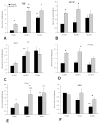Diabetic complications and dysregulated innate immunity
- PMID: 17981625
- PMCID: PMC3130196
- DOI: 10.2741/2757
Diabetic complications and dysregulated innate immunity
Abstract
Diabetes mellitus is a metabolic disorder that leads to the development of a number of complications. The etiology of each diabetic complication is undoubtedly multifactorial. We will focus on one potential component that may be common in many diabetic complications, dysregulation of innate immunity associated with an increased inflammatory response. High glucose levels lead to shunting through the polyol pathway, an increase in diacylglycerol which activates protein kinase C, an increase in the release of electrons that react with oxygen molecules to form superoxides, and the non-enzymatic glycosylation of proteins that result in greater formation of advanced glycation end products. Each of these can lead to aberrant cell signalling that affects innate immunity for example, by activating the MAP kinase pathway or inducing activation of transcription factors such as NF-kappaB. This may be a common feature of several complications including periodontal disease, atherosclerosis, nephropathy, impaired healing and retinopathy. These complications are frequently associated with increased expression of inflammatory cytokines such as TNF-alpha, IL-1beta and IL-6 and enhanced generation of reactive oxygen species. Cause and effect relationship between dysregulation of key components of innate immunity and diabetic complications in many instances have been demonstrated with the use of cytokine blockers and antioxidants.
Figures




References
-
- Cowie C, Rust K, Byrd-Holt D, Eberhardt M, Flegal K, Engelgau M, Saydah S, Williams D, Geiss L, Gregg E. Prevalence of diabetes and impaired fasting glucose in adults in the U.S. population:National and Nutrition Examination Survey. Diabetes Care. 2006;29:1263–8. - PubMed
-
- Donathand M, Halban P. Decreased beta-cell mass in diabetes: significance, mechanisms and therapeutic implications. Diabetologia. 2004;47:581–9. - PubMed
-
- Green EA, Eynon EE, Flavell RA. Local expression of TNFalpha in neonatal NOD mice promotes diabetes by enhancing presentation of islet antigens. Immunity. 1998;9:733–43. - PubMed
-
- Colditz GA, Willett WC, Rotnitzky A, Manson JE. Weight gain as a risk factor for clinical diabetes mellitus in women. Ann Intern Med. 1995;122:481–6. - PubMed
Publication types
MeSH terms
Substances
Grants and funding
LinkOut - more resources
Full Text Sources
Medical
